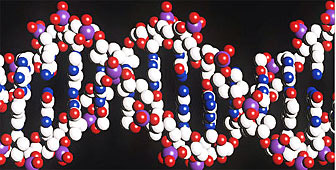
Researchers see DNA as potential power source

Researchers in Zurich and Basel are developing a tiny piece of equipment that can bend DNA. They hope this will be the first of in a new generation of microscopic robots.
The aim is for the robots to be used to diagnose illnesses, read genes, or deliver drugs with pin-point precision.
The researchers at IBM Research in Zurich and the University of Basel say they have discovered that DNA can be used to bend tiny silicon “fingers”, or cantilevers, with a thickness less than one-fifth of that of a human hair.
“If the DNA sequence matches the encoded sequence on the silicon bar, the machine will bend,” James Gimzewski of IBM Research told swissinfo.
The movement could be used to detect genetic variations in the DNA, such as mutations, but could also be harnessed to do work, the researchers say.
“This biomechanical technique has the potential to enable fast and cheap biomechanical analysis, and could be used for mobile applications,” said Christoph Gerber of IBM Research.
One of these applications could be the search for active proteins being produced by cells, including those which the body produces during disease or after injury, such as a heart attack.
“We have found a way to get DNA to do the work for us, so we don’t need batteries, motors or the like to operate tiny machines,” explained Gimzewski.
Such a small device might be used to open a valve, perhaps to deliver drugs in precise doses to exactly the right area of the body.
The new technology might also be deployed in the fight against cancer. The researchers believe the technology could target cancer cells by releasing chemicals in the appropriate area of the body using tiny microcapsules equipped with nanovalves.
This would minimise side effects and make surgery redundant.
However, James Gimweski pointed out that such developments are still some way off, and that this technology has still not been tested on humans.
by Tom O’Brien

In compliance with the JTI standards
More: SWI swissinfo.ch certified by the Journalism Trust Initiative


























You can find an overview of ongoing debates with our journalists here . Please join us!
If you want to start a conversation about a topic raised in this article or want to report factual errors, email us at english@swissinfo.ch.